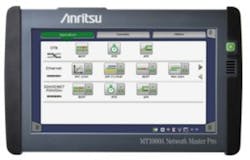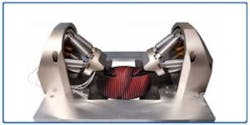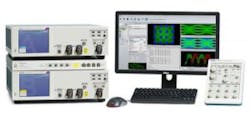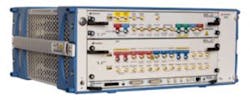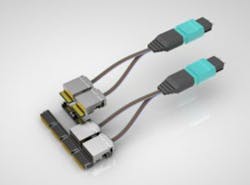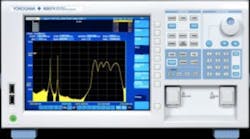Light has long been applied to communications, extending back to smoke signals and semaphore flags. The combination of light with electronics has yielded the high-speed communications we have today. Products for addressing optical communications test range from optical-modulation-analysis software to portable power meters, examples of each of which are provided below. In addition, optical spectrum analyzers can serve applications ranging from environmental monitoring to scientific and medical diagnostics.
Furthermore, engineers often are dealing with optical and electrical communications simultaneously, leading to the introduction of products that address both RF and fiber test. As optics increasingly comes to the circuit board, accessories are emerging that facilitate chip-to-chip, chip-to-board, and board-to-board communications.
The vendor announced it has leveraged its fiber and RF testing capability to develop what it calls the industry’s fastest comprehensive front-haul test solution that efficiently ensures the proper installation and operation of high-speed LTE networks. With the new CPRI RF module installed in the vendor’s Network Master Pro MT1000A, wireless carrier engineers and technicians responsible for optical-fiber testing and solving interference and PIM issues have a single handheld solution for accurate and efficient LTE CPRI testing and verification of the latest generation of tower-mounted radios.
Support for all leading remote-radio-head radios is provided by the new CPRI RF module. It allows the Network Master Pro MT1000A to conduct RF-based LTE measurements over a fiber-optic CPRI link at ground level, eliminating the time-consuming and costly process of climbing a tower. Designed with two SFP ports, the RF module allows CPRI spectrum, CPRI spectrogram, SFP data, and CPRI layer 2 alarms and optical power measurements to be made.
The module features preconfigured NEM (network element manufacturers) setups to simplify what has been one of the most difficult aspects of conducting RF measurements over CPRI. A single-mode optical tap accessory and a combination single-mode/multimode 50-µm optical tap accessory form part of the solution. An SFP matching the connected CPRI link rate and optical cables also is offered.
The CPRI RF measurement capability complements the Network Master Pro MT1000A fiber testing ability. Compact, battery-powered, and easy-to-use, the MT1000A provides everything needed to install and maintain communication networks in a rugged, field-portable package. The mobile front haul fiber test functions of the MT1000A support comprehensive testing and analysis of CPRI and OBSAI technologies. The MT1000A can be configured as a complete solution with support for OTDR and visual inspection probe, to test the complete CPRI infrastructure. The MT1000A supports CPRI interface rate Option 1 (614.4 Mb/s) to Option 8 (10.1376 Gb/s) to test current and future CPRI interfaces.
The lightweight MT1000A enables transport testing from 1.5 Mb/s to 10 Gb/s. An easy-to-use GUI and clear summaries simplify collecting and interpreting data, allowing users of any skill level to operate the instrument. High resolution and dynamic range ensure quick and thorough fiber evaluation, while intelligent analysis software identifies problem splices, connectors, and macrobends. Anritsu
The FMPA Fast Multichannel Photonics Alignment Engine is an alignment system based on a specialized digital motion controller with embedded advanced alignment and tracking functionality and a hybrid precision scanning and tracking mechanism combining the advantages of piezoelectric on servo-motorized drives. The convergence of silicon-based electronics and photonics promises a leap in data throughput, parallelism, and energy efficiency, but test and packaging of silicon photonics elements require nanoscale alignments that cannot be performed using visual or mechanical references. Instead, these optimizations must enhance the optical throughput itself. In addition, SiP designs often incorporate multiple parallel optical paths with multiple interacting inputs and outputs, all requiring optimization.
The FMPA integrates its high-throughput piezo nanopositioning technologies and ultra-precision motion control with novel algorithms. The one-step global optimization system is part of the vendor’s offering of photonics alignment engines ranging from software-driven stage solutions to integrated six-axis hexapod micro-robots with built-in alignment functionality. Physik Instrumente
A series of enhancements to the vendor’s optical modulation analyzer (OMA) software provides optical research engineers with the ability to evaluate multichannel coherent modulation schemes with confidence using a single measurement system. Engineers now can calibrate and control multiple OMAs to easily acquire and analyze simultaneous data from multiple channels such as different wavelengths or fiber cores.
Included in the latest release is a new visual OMA setup tool that facilitates reconfiguration of the oscilloscopes and coherent receiver front-ends so that the same hardware can be used for many different applications like PAM4 research or increased channel count in DP-QPSK testing. The need for multi-channel coherent research is growing with the use of spatial (or modal) division multiplexing that requires an OMA to down-convert and digitize data for each channel. Multicarrier communication applications also require one OMA per wavelength channel when the wavelength separation is more than the OMA bandwidth. Tektronix
The N4917B optical receiver stress-test solution for 100GBASE-LR4 transceivers represents the next generation of test automation. The N4917B provides accurate and repeatable receiver characterization for R&D and validation engineers so they can effectively evaluate their latest 100Gb Ethernet designs. The solution is based on the J-BERT M8020A high-performance BERT (pictured, with the M8062A 32Gb/s BERT front end and M8041A module) and includes the 86100D Infiniium DCA-X high-bandwidth oscilloscope, 81490A reference transmitter, and N77 series attenuator. The newly configured solution allows customers to use the built-in error counters or the BERT’s integrated error detector. Keysight Technologies
The LTK-1 combines the FTB-1750 power meter module in the LTB-1 platform to deliver a low-cost, high-performance benchtop power meter. The FTB-1750 optical power meter delivers high-performance power measurements. The patented design of the FTB-1750 saves time, cuts costs, and enhances measurement throughput. Its 85-dB range and fast stabilization time allow you to simultaneously measure high and low signals on up to four channels. Designed for the LTB-1 benchtop platform, this power meter delivers speed, accuracy, and flexibility in a compact form-factor.
The new Windows-based LTB-1 benchtop platform offers maximum efficiency and flexibility with its Ethernet remote-control port and powerful processor. The new LTK-1 power meter kit provides a touchscreen display and combines an optional inspection probe—the FIP-400B. The kit comes with a web-based user interface and remote control capabilities via its built-in Ethernet port and instrument drivers. EXFO
An extended-temperature version of the vendor’s FireFly Active Optical Micro Flyover Cable Assembly, the new ETUO Series supports temperature ranges of -40°C to +85°C. The ETUO Series shares the core features of the vendor’s existing ECUO Series FireFly Active Optical Micro Flyover Cable Assembly. Both are designed for flexibility and are interchangeable with the FireFly Copper Micro Flyover Cable Assembly using the same connector system. However, the extended-temperature range of ETUO makes it suited for ruggedized applications.
The ETUO Series is immediately available with 12-channel simplex or duplex configurations, enabling 10.3125 Gb/s data rates per channel (123.75 Gb/s aggregate). Additional four-channel simplex and duplex configurations with extended temperature are under development with a targeted spring 2017 release date.
The vendor tests the ETUO Series to ruggedized industry standards. All ETUO solutions demonstrated error-free transmission during MIL-STD-810G shock and vibration testing. Samtec
The new AQ6374 is the successor to the vendor’s AQ6315A wideband optical spectrum analyzer. The AQ6374 offers faster measurements and a purging feature (to minimize the influence of water-vapor absorption on spectral measurements) for general-purpose optical testing over the 350- to 1,750-nm range. By inheriting the control technologies originally developed for the AQ6370 Series, the AQ6374 achieves measurement speeds up to 40 times that of the AQ6315A. The ability to sample 100,001 points of data (100 times as much as the AQ6315A) enables measurement over a broad wavelength range with high resolution, while data-transfer rates during remote control via Ethernet are up to 100 times faster than for the AQ6315A.
The measurement performance achieved by the instrument’s monochromator technology includes a wavelength resolution setting from 0.05 to 10 nm, a wavelength accuracy of ±0.05 nm at 633 and 1,523 nm or ±0.2 nm from 350 to 1,700 nm, a level accuracy of ±1.0 dB, level sensitivity of -80 dBm from 900 to 1,600 nm, a measurable power range from -80 to +20 dBm, a close-in dynamic range of 60 dB (peak ±1.0 nm, resolution 0.05 nm), and a sweep time of less than 0.5 s.
Internal data storage of 512 MB is included, and external data storage is supported via a USB interface. Ethernet RJ-45 and GPIB interfaces also are incorporated. A built-in calibration source is provided for a full-automatic optical alignment and wavelength calibration. Yokogawa
About the Author

Rick Nelson
Contributing Editor
Rick is currently Contributing Technical Editor. He was Executive Editor for EE in 2011-2018. Previously he served on several publications, including EDN and Vision Systems Design, and has received awards for signed editorials from the American Society of Business Publication Editors. He began as a design engineer at General Electric and Litton Industries and earned a BSEE degree from Penn State.

